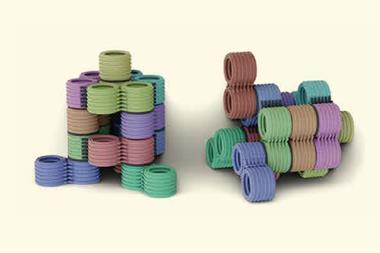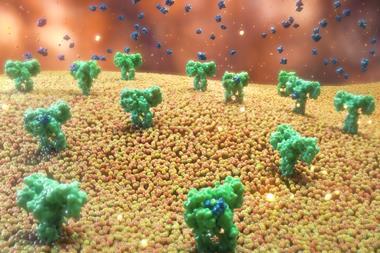Devices made from nucleic acids are starting to find their feet, says Nina Notman
The human body hosts millions of molecular motors and other machines. They keep our lungs breathing, our hearts beating, our brains thinking and our digestive systems gurgling. ‘Life is just amazing. The more we learn about all the incredible functionality that’s present on a microscopic level of life, the more many of us are filled with the desire to be able to recapitulate similar kinds of functionality synthetically,’ says William Shih, a biochemistry professor at Harvard University in Massachusetts, US.
An oft-cited inspiration for researchers in this field is the cult 1966 science fiction movie Fantastic Voyage, where a submarine and its crew were shrunk and sent into the body of an injured scientist to repair his brain. The hope is that, one day, man-made molecular machines will routinely enter our bodies to carry out tasks such as delivering drugs, completing diagnoses and conducting surgical procedures. Other non-medical uses for molecular machines include as analytical tools and as nanofactories for synthesising compounds.
It’s easier to program DNA than proteins
Two categories of building materials are currently being employed in this quest: synthetic organic molecules, which earned their pioneers the 2016 Nobel prize for chemistry, and biological materials, the focus of this feature.
Like child’s play
Nature predominantly uses proteins as the building blocks for its molecular machines, but researchers use DNA instead. ‘It’s easier to program DNA than proteins to make different shapes and functions,’ explains Shih.
DNA stores genetic instructions in the sequence of the four nucleobases – adenine (A), thymine (T), guanine (G) and cytosine (C) – along its backbone. And its single strands always self-assemble into a duplex in a predictable fashion: A pairs with T; G pairs with C. When being used as a construction material, researchers can therefore view the sequence of bases along a DNA strand as a code that specifies that one part of the strand must stick to another part, explains Friedrich Simmel, a biophysics professor at the Technical University of Munich in Germany. ‘We can be more or less ignorant of the chemical complexities because everything is automated and reduced to a code.’
We had to figure out ways to stabilise these structures
It was Ned Seeman at New York University in the US who first thought to use DNA as a construction material. This was in the early 1980s and since then a number of techniques have been developed to build pretty much every imaginable DNA structure from the bottom up. These include DNA origami, the brainwave of Paul Rothemund at the California Institute of Technology in the US, where short DNA ‘staple’ strands are used to fold long single DNA strands into complex 3D shapes. His group has also made DNA tiles and bricks that clip together in a way that is analogous to Lego bricks.
The past few years have seen the successful navigation of two of DNA nanotechnology’s largest roadblocks to widespread use – size and stability. It used to be very difficult to design self-assembling DNA structures larger than about 100nm, explains Hendrik Dietz, a biophysics professor at the Technical University of Munich in Germany. This hurdle was jumped in 2017, when Dietz, Yin and Lulu Qian at Caltech, simultaneously announced three different strategies.
DNA backbones are negatively charged, meaning when they are folded up in close proximity with each other, their natural instinct is to repel, causing the structures to fall apart. In the lab, keeping them in highly positively charged solutions counteracts these repulsive forces. But the body doesn’t offer such a safe haven. Here, the DNA structures would also come under constant attack from DNA nuclease enzymes, whose purpose is to degrade DNA molecules. ‘What we had to do was figure out ways to stabilise these structures so that when you take them out of the fabrication conditions and into the application conditions they survive,’ explains Dietz. His group and Shih’s have both recently developed approaches to achieve this by chemically crosslink structures together. ‘It is finally possible to have these structures survive for weeks, or longer, inside the body,’ Shih says.
Getting a jiggle on
A big stable structure on its own doesn’t make a machine: they need to be able to move. Configurations with a mixture of components that are rigid, such as duplexes, and flexible, such as single stranded DNA, do inherently move around due to Brownian movement, says Simmel. But getting them to do so in a highly controllable fashion is extremely challenging.
The predictable and programmable behaviours of DNA, so very important during self-assembly, are also the key here. The year 2000 saw Bernie Yurke, then a researcher at Bell Laboratories, Andrew Turberfield, a physics professor at University of Oxford, UK, and Simmel reveal the first – and still most widely used – method for directing movement: a DNA-partner swapping process known as a strand displacement reaction. ‘You replace one strand in the duplex, or part of that strand, with another strand that has the same [base] sequence,’ explains Turberfield.
A DNA walker, for example, can repeatedly swap partners by zipping and unzipping duplexes to enable its ‘feet’ to travel up and down a track of pegs containing complementary base pairs.
The robot knows where each cargo goes
In 2017, Lulu Qian and her Caltech colleagues demonstrated a DNA cargo transporter able to sort cargo using the strand displacement reaction. This DNA cargo-sorter can wander across a surface picking up discarded pieces of cargo and sorting it into distinct piles; like us collecting discarded dirty laundry from around our homes and sorting it into neat piles of colours and whites.
The surface this DNA machine is walking upon is a 2D DNA origami structure with pegs of single-stranded DNA. The cargo is single strands of DNA containing a DNA barcode tag. And the robot is a single-strand of DNA with three distinct sections: feet for walking, a hand for cargo collection and transportation, and a segment that can read the tags.
The robot is designed to walk randomly around the surface until it bumps into a piece of cargo. It picks this up and continues randomly travelling until it reaches a drop-off point. If the barcodes of the cargo and the drop-off point match, the robot will unzip the cargo from its hands. ‘The robot knows where each cargo goes because each one has a DNA barcode tag that only matches one of those destinations,’ says Erik Winfree, a Caltech computer scientist and Qian’s collaborator for this research.
The initial demonstration of this machine saw the robot sort DNA with green and red fluorescent dyes. But the team says it should also be able to sort other small molecules such as aptamers, antibodies, small chemicals, metal nanoparticles and proteins.
‘The transportation of objects from point A to point B is something that is very important,’ explains Shih. ‘In an electronic device you have electrons that flow from one place to the other to switch the state of the machine. By analogy, one can have physical movement of matter to accomplish the same thing.’
Speeding things up
The DNA cargo-sorter is quite slow, sorting six dye molecules into two piles in 24 hours , and to speed up the process the team used multiple robots concurrently. Another way to speed things up is to have the machines travel directly from A to B, rather than take a random walk. But this is harder than it sounds. One way to create a forward bias in the system is to use short strands of DNA, referred to as a chemical fuel, that get involved in the strand displacement reaction. ‘It’s a tool for designing non-equilibrium reaction networks,’ explains Turberfield, who developed the concept. ‘It’s a clever kinetic trick that makes removal of the foot behind faster than the one who’s in front,’ adds Shih.
Currently, Shih’s lab is using chemical fuel to power DNA nanocallipers that walk around macromolecules taking measurements. These pincher-like tools wrap around objects at various locations, and how much they have to expand to cover the object at each point on its surface signifies the length of the object there, says Shih. The end goal is to decipher the 3D structure of macromolecules faster than is currently possible using traditional tools such as x-ray crystallography. ‘Instead of directly imaging the molecules, we have these little callipers that measure all these pairwise distances, and then we fed those distances into a structural prediction program, and it could reconstruct what the overall 3D shape is to great detail,’ Shih explains. He is working with his Harvard colleague Wesley Wong to develop this tool.
Use the force
Other ways of speeding up DNA machines include changing the pH value of the solution they are in, adding ions, illuminating them with light or zapping them with electricity. Simmel’s lab has adopted the latter approach for controlling its DNA robotic arm. The arm moves about 100,000 times faster than typical DNA machines, says Simmel.
The arm is a bundle of rigid duplexes attached to a 3D DNA origami platform by single strands of DNA. This flexible joint allows the arm to rotate with respect to the platform. Because DNA is negatively charged, the arm moves towards it when an electric field is applied to the system. Simmel has also introduced a series of docking stations to the platform to increase the positional control he had over the arm. The platform and the arm have complementary protruding short strands of DNA that hybridise when they are in close proximity, holding the arm still.
Simmel’s lab demonstrated his arm transporting both organic florescent dye molecules and gold nanorods around the platform. One potential use for this cargo-transporting device is in a molecular version of a factory assembly line, he explains, where molecules could be rapidly constructed following instructions from an outside operator.
Supersize me
One potential application for DNA machines is in the control of macroscale robots. ‘My group is making machines that integrate traditional soft materials, like hydrogels, with dynamic DNA components that drive their motion,’ says Rebecca Schulman, a biomolecular engineering professor at Johns Hopkins University in Baltimore, US. These robots are on the scale of 10µm to 10mm.
We get a 100-fold change in volume
The Schulman lab’s hydrogels are held together by DNA duplexes, rather than the more typical small molecule crosslinkers. ‘Our materials contain polyacrylamide physically crosslinked by hybridized DNA,’ she says. The team uses a strand displacement reaction to make the hydrogel swell. Multiple hairpin-shaped DNA molecules are inserted into the DNA duplex crosslinks to extend them, which causes the hydrogel to grow. ‘There is this dramatic change in size of this material as they are growing,’ says Schulman. ‘We get a 100-fold change in volume.’
The team is using this phenomenon to direct movement in a macroscale robot, by controlling when each part of it swells. ‘We put different kinds of DNA hydrogels on different parts of the device,’ she explains. Each hydrogel contains different base sequences in the crosslinking duplexes and swells only in response to matching DNA hairpins. Using this approach, the team has demonstrated the folding of specific petals on hydrogel flowers and fabricated a crab with antennae, claws and legs that each curl in response to different DNA hairpins.
The end goal is to design robots that autonomously move in response to external stimuli. One approach the team is taking towards this end is designing sensors that release DNA hairpins that cause a device to move in response to a stimulus such as a specific small molecule. ‘These are the primitive beginnings of not just a robot, but a controller,’ says Schulman.
Possible applications for these devices include as intelligent capture devices that detect and move towards chemical gradients. ‘The ability to move in response to chemical signals detected in the distance could allow robots to find and pick up particular types of cells or debris. Robots like that could perform biopsies or keep surfaces exquisitely clean,’ says Schulman.
Telling the time
Elisa Franco’s lab at the University of California Los Angeles in the US is focusing on a different aspect of timing control for autonomous DNA machines. ‘I am interested in understanding how we can make DNA nanostructures that change their shape in response to stimuli,’ and which do so at regularly occurring intervals, she explains.
In 2019, her lab revealed DNA nanotubes that assemble and disassemble periodically. The nanotube building blocks are DNA tiles with multiple single DNA strands dangling off them. The tubes assemble when complementary strands from different tiles form a duplex, and disassemble when invader strands come in and break up that pairing. Reassembly is then triggered by anti-invader strands displacing the bound invader strands, leaving the tiles free to form nanotubes again. ‘We have monomers that are nanometre scale but then they grow up in minutes to tubes that are microns in size,’ says Franco.
We’re studying how we could build an artificial cytoskeleton made of DNA
The researchers were inspired by the cell cytoskeleton, a network of tubes that grow periodically through cell division. ‘We wanted the same action that’s repeated over time,’ Franco says. Invader and anti-invader strands can just be added to the system manually, in repeated cycles, to control tube assembly and disassembly. But with a mind towards autonomous control, the team coupled the system to a synthetic molecular oscillator that regulates the release of the two strand types.
The oscillator is made up of a negative feedback loop of two synthetic DNA genes, coding for the invader and anti-invader strands, and two enzymes – a RNA polymerase that produces the strands and a ribonuclease that degrades them. The oscillatory behaviour of the genes is driven by the periodic production and degradation of the invader and anti-invader strands.
Ultimately, Franco would like these nanotubes to be used in a functioning artificial cell. ‘Right now, we’re encapsulating this system inside water droplets,’ she says. ‘The droplet is a minimal equivalent to a cell and so we’re studying how we could build an artificial cytoskeleton made of DNA.’
On the factory floor
DNA machine designers are also being inspired by another piece of cellular machinery: the ribosome. These molecular protein factories move along strands of messenger RNA, assembling amino acids (tagged with transfer RNA molecules) in the order coded for in the mRNA base sequence.
DNA in the arc of history is a prototyping material
Researchers are using the same concept to direct polymer synthesis. ‘With Rachel O’Reilly’s group in Birmingham, we’re developing molecular machines for gene-programmed polymer synthesis,’ explains Turberfield. In this set-up, strands of artificial DNA play the role of mRNA and tRNA, and synthetic monomers substitute for the amino acids. ‘We’ve got a soup of different building blocks and they’re identified by bits of DNA that are analogous to the tRNA. Our machine is programmed by a gene: it recognises those adapter sequences and brings the building blocks into proximity with the growing polymer to force them to react in the programmed sequence,’ Turberfield explains.
This autonomous system has already linked many different natural and unnatural building blocks using both peptide and alkene bonds and without the need for purification. Turberfield is hopeful that the technology will find use in the pharmaceutical industry to rapidly synthesise large combinatorial libraries for use in drug lead discovery. The idea is that they’ll make a soup of around a trillion different gene-programmed molecules in a single pot with their DNA tags still attached, he says. This soup will then be screened against the drug target and if there is a positive response, the DNA tag can be used to identify the molecule responsible for the ‘hit’.
Ultimately, as successful as DNA is proving to be as a programmable construction machine for molecular machines, many researchers in this field expect that DNA will eventually become obsolete for this purpose. It will be superseded by new natural and man-made materials that also self-assemble but which are stronger or more useful in other ways, such as having electronic or magnetic properties, says Shih. ‘DNA in the arc of history is a prototyping material, where we can test different ideas of how to compile function, before eventually diversifying into other materials.’
Dietz agrees. ‘In physics, we often subscribe to the philosophy of picking a simple system and learning as much as we can about it before cranking up the complexity.’
Nina Notman is a science writer based in Salisbury, UK













No comments yet